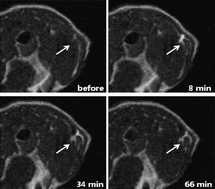We demonstrate the synthesis and characteristics of MRI-active Gd2O3 core/SiO2 shell/poly(2-methacryloyloxyethyl phosphorylcholine) corona composite nanoparticles (Gd2O3@SiO2@PMPC NPs). The prepared NPs have a number of attractive features in cancer diagnosis and neutron capture therapy (NCT): biocompatibility, colloidal stability, low cytotoxicity, nucleus affinity, passive targeting, etc. Monodisperse and highly crystalline Gd2O3 NPs were prepared using a polyol protocol to control the average particle size and surface properties. The Gd2O3 NPs were then functionalized with SiO2 and a biomimetic layer of PMPC, to achieve reduced toxicity and enhanced nucleus affinity, for use as an MRI-active Gd-NCT agent. The size of the NPs was tailored to be from 50 to 100 nm for passive accumulation in tumor tissue through loosened capillary vessels. The morphologies and structures of Gd2O3, Gd2O3@SiO2–Br, and Gd2O3@SiO2@PMPC NPs were studied by FT-IR, XRD, HR-TEM, and TGA. In vitro cytotoxicity was investigated with three kinds of normal and cancer cells, and in vitro and in vivo MRI analyses were performed to confirm the contrast ability, accumulation, and sustentation of NPs in tumor tissues.

You have access to this article
 Please wait while we load your content...
Something went wrong. Try again?
Please wait while we load your content...
Something went wrong. Try again?


 Please wait while we load your content...
Please wait while we load your content...